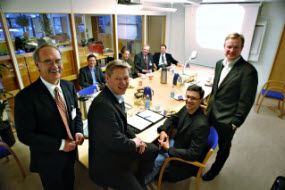
|
The industrial innovation services at SINTEF in Trondheim, Norway and Sweden's Karolinska Institut in Stockholm are collaborating on the development and commercialisation of a new antibiotic. From the left: Ola Flink of Karolinska Innovations AB, Hans Arwidsson and Sergey Zotchev of the newly formed company Biosergen AS and Anders Lian of Sinvent, SINTEF's commercialisation company. |
The company is a fruit of the research that has given a group of scientists at NTNU and SINTEF detailed knowledtge of the inner life of the soil bacterium known as Streptomyces noursei. This microbe produces a substance called Nystatin, an antibiotic that is used in medicines used for treatment of fungal infections in human beings.
Biosergen will utilise gene technology to develop variants of the Nystatin molecule. The aim is to produce analogues of Nystatin that are less toxic than today’s fungus-killing antibiotic and that will thus have fewer side-effects when such medicines are taken internally.
This would help patients suffering from cancer, HIV and recovering from organ transplants: such patients are more liable to suffer from severe fungal infections because their immune system is weakened.
Designing new molecules
There is already a wide range of antibiotics on the market today - complex molecules produced by micro-organisms in order to outcompete other microbes in the struggle for food. It is precisely this ability to kill micro-organisms that has made antibiotics such an essential part of the fight against many infectious diseases.
Now mid-Norwegian industry has joined the race to succeed on this front. The new company Biosergen AS has opened its offices in Trondheim with a staff of two.
The company will utilise new biotechnology tools that have been developed at NTNU and SINTEF, including a method that will allow it to design specific new biological molecules that would otherwise have been impossible to create.
Controllng the micro-factory via the genes
Nystatin is formed inside the producer bacteria in a complex chemical “factory”. The bacteria produce enzymes that catalyse the production process. The NTNU/SINTEF team has experimented with changing the part of the bacteria’s genetic material that determines how the enzymes will operate. With the aid of this technique, the scientists have already engineered the bacteria to produce variants of Nystatin.
Markets worth billions
Developing new medicines is an expensive business. Biosergen expects to spend about NOK 50 - 80 million ion developing its new antibiotic. At the same time, sales in this industry can reach dizzying levels.The part of the market fopr medicines that the new company is aiming at is worth some USD 4.3 billion a year, a figure that is expected to double by 2012.
Norwegian-Swedish brotherhood
SINTEF’s seed-corn fund and the Karolinska Institute’s holding company in Stockholm now hope to take their share of this market. Each of these two companies owns 50% of the new Trondheim company. The Karolinska’s share will soon be transferred to a fund that is being built up and which will be controlled by the Swedish institute’s innovation apparatus.
Active investment engine
In the case of Biosergen, the route from idea to company establishment has passed through SINTEF’s “investment engine”, an activity which aim is to commercialise technology that has its origins in SINTEF’s research. In the course of this activity SINTEF puts its efforts into patenting, market research and developing business plans. When a project reaches the stage of commercialisation and company formation, SINTEF’s seed-corn fund goes in on the ownership side.
The investment engine has been going for almost two years, and has already given birth to five companies. Three technologies have also been licensed to others. The new companies include Revolt Technology AS, which has introduced a new type of electric battery based on a combination of classical battery technology and fuel-cell technology.
Contact:
Hans Arwidsson, email:
Sergey Zotchev, email:
